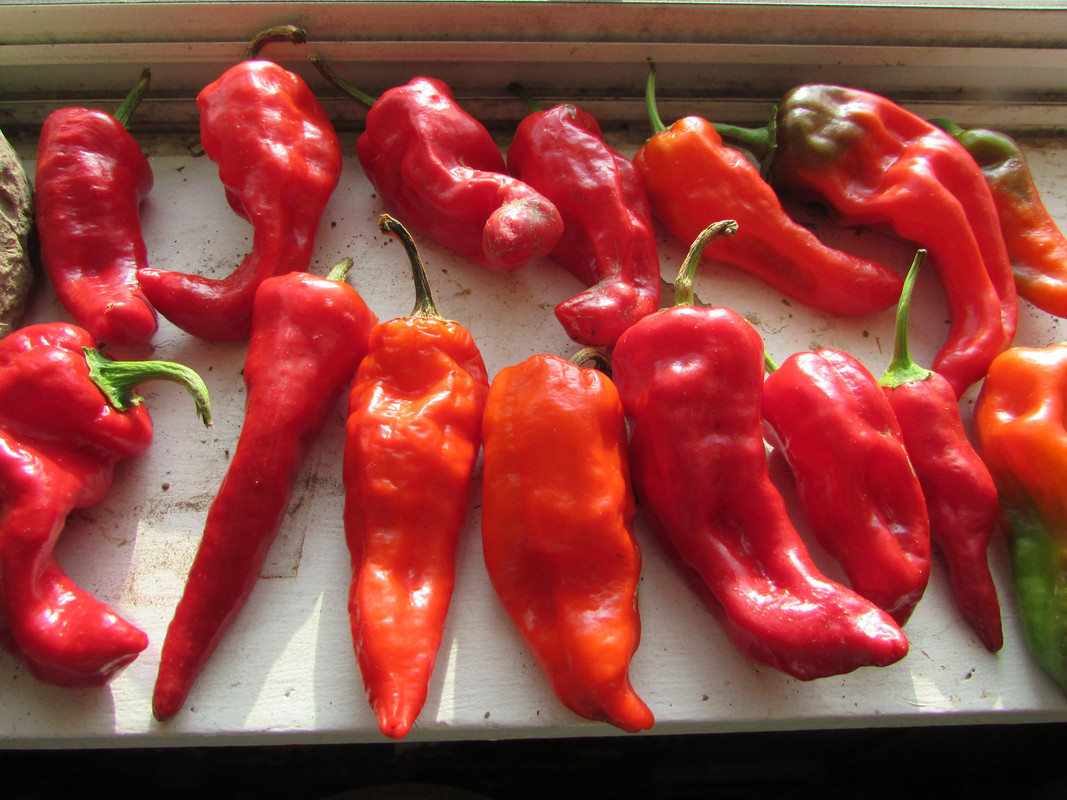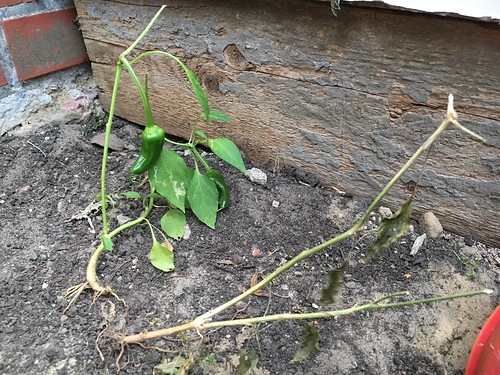|
|
Post by diane on Jun 10, 2018 15:13:59 GMT -5
Did you sow the seeds directly in the garden, or in pots first?
|
|
|
|
Post by imgrimmer on Jun 10, 2018 16:22:15 GMT -5
they are direct sown in a coldframe. spring is really warm more like summer so conditions are good for peppers. the other peppers are also direct sown but weeks before Canoncito.
|
|
|
|
Post by oxbowfarm on Jun 15, 2018 6:41:26 GMT -5
I've got a mini New Mexico Landrace Pepper trial going, I've been interested in Canoncito for a few years. I decided to do a trial planting alongside some other New Mexican landrace strains available from NS/S. I have to say the Canoncito seed from Wild Garden was much higher quality in terms of germ and vitality than the NS/S seeds, I have about 20 Canoncito plants and only a handful of the other varieties, which include San Juan Tsile, Chimayo, Isleta, and Tarahumara Chile Colorado. The Tarahumara chile isn't actually a New Mexican pueble landrace, but it seems pretty similar. And after my great experience with Tarahumara corns, I'm ready to give anything Tarahumara a shot in my conditions.
I'm really interested in a pepper I can grow quickly outdoors and produce good yields of dryable red chiles. So I have high hopes for this group of peppers.
|
|
vivi
gopher

Posts: 1
|
Post by vivi on Jun 28, 2018 19:49:57 GMT -5
I have a few Canoncito plants in my zone 3b garden. Started indoors March 25th in flats, transplant tiny seedlings to deep 24 oz cottage cheese containers, into "Black Gold" brand organic potting soil. Fed with weak fish emulsion-kelp 1x week.
We cannot do peppers direct seed as we often have late frosts, in fact this April we had well over 20 inches of snow.
Today I picked 2 5 inch long ripe Canoncito peppers! Mildly spicy. Also have jalapeno (my own strain), Avjarski, Leutschauer and some other more ordinary peppers.
I am astounded to read of the difference in taproot & root development, and how this can affect the gene pool. Something I just never considered in 30 years of huge backyard gardening (1,500 sf not including fruit gardens).
Thank you so much for sharing all this info!
|
|
|
|
Post by oxbowfarm on Aug 31, 2018 8:31:04 GMT -5
The patch of New Mexico landrace chiles I planted is starting to ripen. I've actually missed several Cañoncito fruits that have ripened and rotted in the rain. Part of the problem is probably related to the way the pepper has been selected for rapid growth from direct seeding as per farmher . Since I transplanted all these peppers, the root systems and stem strength wasn't what a field sown plant would have. So I've got most of my Cañoncito plants are fallen over and are growing on their sides with shoots forcing up vertically. This puts all the earliest peppers on the ground and leads to slug and insect attack and rotting. It also doesn't help that I planted the tomatillos too close and they are starting to try and climb over the Landrace pepper row. 6 feet away was too close. Mostly what I have ripe is Cañoncito and a few Chimayo. San Juan Tsile, Isleta, and the Tarahumara Chile Colorado are all covered in fruit, but no ripening so far. I have to say I really like the plants on the Tarahumara Chile Colorado. Very tall and sturdy with strong branches. Here's my harvest so far, minus the ones I've already put into salsa etc.  |
|
|
|
Post by imgrimmer on Aug 31, 2018 9:47:25 GMT -5
did you find some sweet fruits among them? How hot are they?
My plants are all on the ground and have very weak stems. There is one large green fruit I still wait for and several smaller (younger) ones.
|
|
|
|
Post by oxbowfarm on Aug 31, 2018 16:43:15 GMT -5
did you find some sweet fruits among them? How hot are they? My plants are all on the ground and have very weak stems. There is one large green fruit I still wait for and several smaller (younger) ones. I haven't found any fruits without heat. It is so difficult to describe pepper heat, because it is so subjective, but I'd call the Cañoncitos that I've had to be very mellow, low heat peppers. The burn in on the lips and front of the tongue, and my scalp will sometimes sweat slightly on a stronger one. They really are quite a gentle pepper from a heat standpoint. Which is perfect because you can use a lot of them in a dish and get the intense pepper flavors without burning out your guests. Dried peppers of this type are super versatile in the kitchen IMO, much more than ridiculous super-hots which are only edible by a tiny fraction of people. |
|
|
|
Post by imgrimmer on Oct 9, 2018 15:12:20 GMT -5
today I ate the first fruit. it was kind of sour and no heat at all. It is very thin walled. Not the kind of pepper I am interested in but it is very short season.
What made me wonder is when the fruit stopped growing it took weeks until it changed its color.
|
|
|
|
Post by imgrimmer on Dec 8, 2018 3:47:26 GMT -5
First frost emerged. One Canoncito plant survived -1°C ( 30,2°F)for 2 days. Others died as suspected.  |
|
|
|
Post by alongshore on Feb 21, 2019 8:19:56 GMT -5
I’ve been growing this now for 2 years in MA on cape cod and it works really well. I got the seed from Wild Garden the first year they had it. I’ve only started them indoors, no grow lights just from a table on my sliding glass door facing south. If a pepper can’t grow there starting in Feb I’m not interested.
I’ve grown it in the ground as well as in containers and haven’t seen a difference in output.
Just about all the peppers are thin walled.
I also think it has crossed with another chili I’ve grown for years called flame tongue- flame tongue now has larger pods which I’ve been selecting for.
What I really like about this pepper is that it turns red quickly - flame tongue is the only other chili that is about the same in timing - right around salsa season here - mid August 😀
|
|
|
|
Post by alongshore on Feb 21, 2019 8:21:59 GMT -5
Oh and the heat level is about the same as a green jalapeño- not a lot of heat but also good fruity flavor when red.
|
|
|
|
Post by imgrimmer on Feb 21, 2019 10:15:15 GMT -5
How do you eat it? I had fruits for the first time. Fruits make a good chili powder but are not good for fresh eating.
Do you sow in February and harvest in August?
|
|
|
|
Post by alongshore on Feb 21, 2019 10:44:46 GMT -5
How do you eat it? I had fruits for the first time. Fruits make a good chili powder but are not good for fresh eating. Do you sow in February and harvest in August? We eat alot of Mexican-style food at my house, so we just sliced them up and put them in our bean burritos, tacos, etc. I also just chopped up and added to salsa with seeds and all.
I start them in February from seed and they turn red by August for me - we are surrounded by water so our Spring is very cold and basically we go from winter to Summer and skip spring these days.
I just bulk started all my peppers last night including these  |
|
|
|
Post by alongshore on Feb 21, 2019 10:47:57 GMT -5
I have also added them to my hot pepper mix & hot sauce mix at the end of the season. Basically I'll take all my hot peppers right before the first frost and cook them outside on my rocket stove - wiz em up, add vinegar and use that hot sauce. Sometimes just whiz them all up and add vinegar and put in mason jars to be used as a relish - super good and fruity when you add habaneros and aji lemons.
How do you make your chili powder?
|
|
|
|
Post by imgrimmer on Feb 21, 2019 11:13:39 GMT -5
I didn`t make it by purpose. They just dried on the window sill and I found out it makes a good chili powder.
|
|